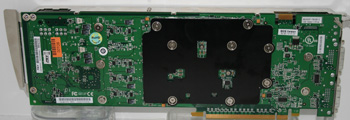NVIDIA Quadro FX 5600
The Basics
Think of a GeForce 8800 GTX with double the memory and you're not far away from realising the specification of a Quadro FX 5600 in terms of on-paper rendering performance. Obviously there's a bit more to the Quadro FX 5600 than the frequencies of the GPU and the size of the framebuffer, though. The aforementioned support for driving two 3.8x2.4K displays at a video-friendly 24Hz is one, and with NVIDIA's G-Sync partner board there's the genlock support that certain markets require. There's no G80-based Quadro that supports SDI connection to broadcast video systems, however, so you'll have to wait for that if you're in the TV or film business for your real-time overlay and related systems and require features that G80 provides.Quadro FX 5600 has frequencies of 600MHz for the base clock, an apparent (based on a quick look at the VGA BIOS image) 1400MHz for the hot clock and 800MHz for the 24 GDDR3 DRAM devices. NVIDIA's documentation for the FX 5600 seems to hint at a peak triangle rate of 0.5/tri per clock, but we measure closer to 1/tri clock, for a probable peak rate of 600Mtris/sec. The base and hot clocks are higher than GeForce 8800 GTX, but the memory clock is less, resulting in 76.8GB/sec of peak on-board memory bandwidth between GPU and DRAMs.
Theoretical Rate Testing
We measure sample rate just shy of peak at ~19000Mtexops/sec for most width/channel combinations (much like you'll see here for 8800 GTX) using our in-house tester, with measured colour only ROP rate close to peak at ~14Gpixel/sec. Peak instruction rates are available using our short shaders for MAD and ADD, and testing transcendentals shows the same performance per clock as GeForce 8800 GTX, at least using the WHQL ForceWare 97.78 driver. Therefore the GPU is allowed to work at peak or close for the rendering basics, be that shading or output of pixels, or triangle setup, as you'd expect. Application-level performance is another matter, hower, which we'll investigate in coming pages.The Board
The board was supplied by UK-based high-performance system builder Armari, as part of a workstation system build based around a 2S Intel Xeon X5355 (Core-based, 2.66GHz) and Intel i5000X platform. More about the Magnetar QX2 on the system setup page.The PCB width makes consumer-level boards look tiny, with 312mm of PCB plus optional bracket to find room for in any target chassis. The PCB-level differences compared to (the 267mm) 8800 GTX are reasonably minimal as it happens, with most of the differences targetted at the power plane (mostl likely for the extra memory) and component placement make it physically long enough to satisfy chassis mounting requirements. The cooling system exhausts tranferred heat out from the rear of the chassis, with noise levels almost identical to the GeForce consumer-level board we've been comparing it to so far. That means it's almost silent under normal usage profiles, with the fan only spinning up to 100% speed under particularly prolonged and heavy GPU and framebuffer loads.
NVIDIA state a power requirement of 171W, and we measure that to be reasonably accurate with a 182W peak load in our test system (with possible testing variance, the board and slot power isn't isolated during measurement). Two 6-pin +12V connectors are therefore required to keep the board happy in terms of power supply, and you can see those on the board edge. You'll also note a single SLI connector for the Quadro FX 5600, used to pair with another (and NVIDIA supply a Quadro Plex with two in that very configuration). Note that PNY are the noted vendor, although none of NVIDIA's AIB partners for Quadro FX 5600 are responsible for board manufacture. PNY's customisation runs to simple BIOS branding.
It's worth noting that a Quadro FX 5600 plus G-Sync is officially called Quadro FX 5600G, although the G-Sync board wasn't supplied with the workstation. The board simply won't fit in to almost all consumer-level system chassis. Our desktop workstation chassis of choice, the Akasa Eclipse-62, will only accomodate the board if you don't install HDDs in the cage at the front of the chassis parallel to slot locations the board would occupy. Armari use a really nice chassis from Chenbro for their Magnetar QX2 builds, which houses Quadro FX 5600 without issue.













